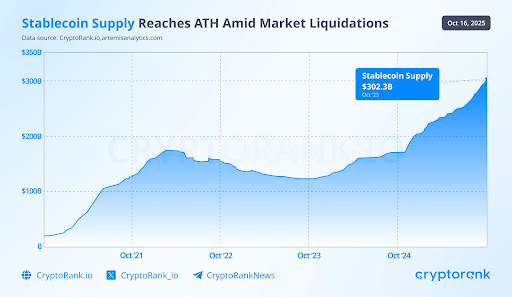- Stablecoin supply has jumped to $302.3B in 2025, showing more money flowing into crypto and growing market trust.
- Tether leads the pack with $181.4B, holding 60% of the market as traders and companies use it for smooth transactions.
- Ethereum might hit $10,000 soon as more people and big investors use its network for apps, finance, and digital tokens.
Stablecoin circulation has increased in the cryptocurrency market. According to CryptoRank and Artemis Analytics on X, the total stablecoin supply peaked at $302.3 billion as of October 2025.
The data indicates that from early 2020, there has been a consistent, long-term upward trend in the circulation of stablecoins. The supply, which began at less than $50 billion, showed the early expansion of digital assets.

Its worth increased to more than $100 billion by the end of 2021 as its use expanded across DeFi systems and exchanges. A correction decreased circulation amid market contractions, although the overall value momentarily exceeded $250 billion in mid-2022.
However, stability returned through 2023, with supply averaging near $150 billion. From early 2024, growth reignited, signaling renewed investor confidence and increased liquidity inflows. Consequently, the market entered a phase of sustained expansion throughout 2024, driven by the rise of new entrants such as $USDe, $USD1, and $PYUSD.
These additions, alongside the U.S. GENIUS Act, fueled institutional interest in regulated digital dollar alternatives. By mid-2025, the sector recorded a sharp acceleration, breaking prior highs and reinforcing its crucial liquidity role.
Tether’s Dominance and Ethereum’s Institutional Momentum
With a current supply of $181.4 billion, Tether (USDT) now holds close to 60% of the stablecoin market. DeFiLlama claims that USDC, with a market share of 24.6% and 75.7 billion tokens, comes in second. These numbers show the ongoing demand for dependable liquidity from institutions and on-chain dealers.
Meanwhile, Citizens Bank projected that Ether (ETH) could climb above $10,000 within two years. The bank cited rising adoption, institutional inflows, and Ethereum’s shrinking supply as key factors.
“Ethereum’s programmable infrastructure underpins decentralized finance, tokenization, and on-chain applications,” the bank noted. Its strong developer base and modular scaling continue to strengthen its leading position in the blockchain sector.





